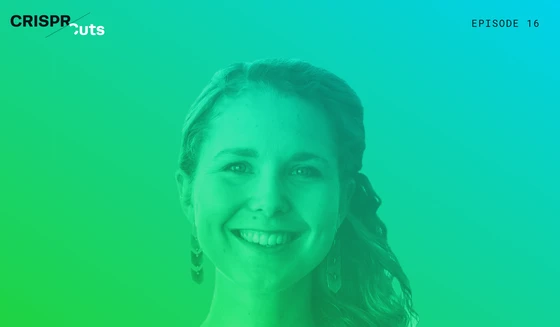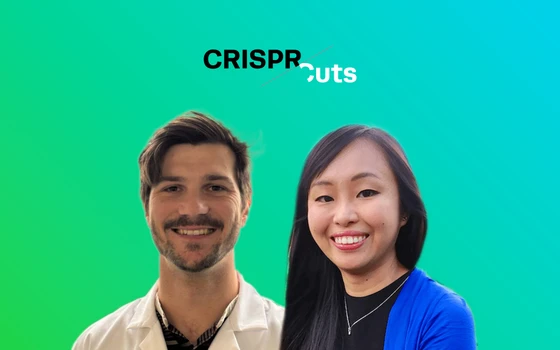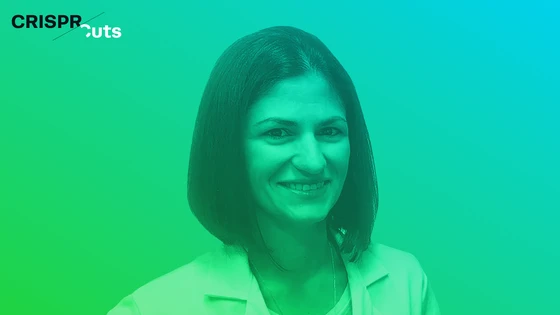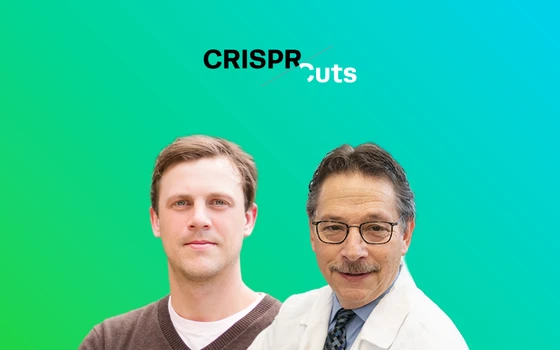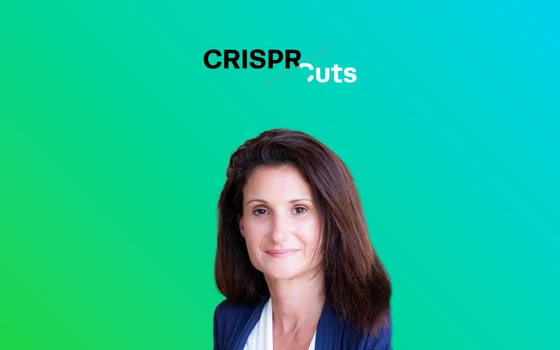Contents
Introduction of CRISPR as a genome engineering tool has ushered in great hope in the field of therapeutics. Researchers are working hard to find cures for diseases that stem from genetic mutations using CRISPR. One barrier in this process is to figure out how to specifically deliver CRISPR components in vivo.
In this podcast episode, Dana Foss, a postdoctoral researcher at the Innovative Genomics Institute (IGI), discusses how her lab is working to overcome the CRISPR delivery hurdle. She also discusses the present state and future expansion of CRISPR in therapeutics.
Listen to the podcast here, or jump down and start learning & reading the podcast transcript — the choice is yours!
CRISPR Therapeutics: How It’s Transforming Disease Research
CRISPR-Cas9 has been revolutionizing many areas of medical research and has been successfully used to probe gene function. Recently, CRISPR-mediated gene therapy has been garnering a lot of attention for its potential to transform human disease research.
What is CRISPR therapy?CRISPR therapy is a form of gene therapy that uses CRISPR technology for disease treatment. It typically involves alteration of DNA to correct the effect of a mutant gene that is causing the illness. Researchers have been developing CRISPR mediated therapies for a wide range of diseases including sickle cell anemia, muscular dystrophy and several types of cancer.
CRISPR therapy is a form of gene therapy that uses CRISPR technology for disease treatment. It typically involves alteration of DNA to correct the effect of a mutant gene that is causing the illness. Researchers have been developing CRISPR mediated therapies for a wide range of diseases including sickle cell anemia, muscular dystrophy and several types of cancer.
Why CRISPR-based treatments seem promisingThe ability to introduce desired changes into genomes at precise locations makes CRISPR an invaluable tool for disease therapy. CRISPR technology is very simple, easy to use, cost effective when compared to other gene-editing techniques. The ability to introduce desired changes into genomes at precise locations, makes it an invaluable tool for disease therapy.
In several animal disease models, CRISPR has been used to knockout mutant genes or for knock-in experiments to replace faulty genes. However, for CRISPR technology to be extended for clinical applications, several hurdles need to be overcome –– one major challenge that scientists are facing is efficient in-vivo delivery of CRISPR. In the next section, we will discuss the current CRISPR delivery methods being used and the challenges that they pose.
The ability to introduce desired changes into genomes at precise locations makes CRISPR an invaluable tool for disease therapy. CRISPR technology is very simple, easy to use, cost effective when compared to other gene-editing techniques. The ability to introduce desired changes into genomes at precise locations, makes it an invaluable tool for disease therapy.
In several animal disease models, CRISPR has been used to knockout mutant genes or for knock-in experiments to replace faulty genes. However, for CRISPR technology to be extended for clinical applications, several hurdles need to be overcome –– one major challenge that scientists are facing is efficient in-vivo delivery of CRISPR. In the next section, we will discuss the current CRISPR delivery methods being used and the challenges that they pose.
CRISPR Delivery: Current Methods and Challenges
CRISPR technology has shown immense promise as a therapeutic tool that could potentially correct many disease-causing mutations. However, for it to effectively function as a therapeutic system, it must be transported directly to target location in the cell. So let us learn about some of the delivery vehicles that are that are currently being used to transport CRISPR.
CRISPR delivery methodsThere are two main methods classifications of CRISPR delivery systems –– viral and non-viral delivery. Viral delivery is one of the popular methods that has been used for achieving Cas9 expression in cell culture. Adeno-associated virus (AAV) is the most commonly used viral vector for Cas9 delivery, but lentivirus and retrovirus have been used as well.
Non-viral delivery techniques of CRISPR include electroporation, lipofection, and microinjection. Electroporation works by exerting an electric field onto a cell’s membrane, making it more porous and non-selective. The increased permeability allows biomolecules to pass through and can be used for in vitro applications and cell lines for delivery of DNA and RNA.
Each of these delivery methods have their advantages and disadvantages. Confused which method to choose for your experiment? Check out this guide chapter to learn more about transfection methods.
There are two main methods classifications of CRISPR delivery systems –– viral and non-viral delivery. Viral delivery is one of the popular methods that has been used for achieving Cas9 expression in cell culture. Adeno-associated virus (AAV) is the most commonly used viral vector for Cas9 delivery, but lentivirus and retrovirus have been used as well.
Non-viral delivery techniques of CRISPR include electroporation, lipofection, and microinjection. Electroporation works by exerting an electric field onto a cell’s membrane, making it more porous and non-selective. The increased permeability allows biomolecules to pass through and can be used for in vitro applications and cell lines for delivery of DNA and RNA.
Each of these delivery methods have their advantages and disadvantages. Confused which method to choose for your experiment? Check out this guide chapter to learn more about transfection methods.
Challenges with current CRISPR delivery systemsViral vectors have shown high efficiency in gene delivery and expression. However, the main concern over using them is their potential in carcinogenesis and immunogenicity. Another challenge faced by this delivery system is that the DNA packaging capacity is limited and might not be sufficient to transport larger enzymes.
The non-viral delivery methods have several advantages over viral methods such as low immunogenicity and have larger DNA packaging capabilities. Low delivery efficiency, however, is a barrier for these approaches. Scientists are coming up with new non-viral delivery methods that have high efficiency. In this podcast, Dana Foss, discusses the non-viral approaches her is working on to solve the issues of CRISPR-Cas9 delivery.
Viral vectors have shown high efficiency in gene delivery and expression. However, the main concern over using them is their potential in carcinogenesis and immunogenicity. Another challenge faced by this delivery system is that the DNA packaging capacity is limited and might not be sufficient to transport larger enzymes.
The non-viral delivery methods have several advantages over viral methods such as low immunogenicity and have larger DNA packaging capabilities. Low delivery efficiency, however, is a barrier for these approaches. Scientists are coming up with new non-viral delivery methods that have high efficiency. In this podcast, Dana Foss, discusses the non-viral approaches her is working on to solve the issues of CRISPR-Cas9 delivery.
3 Key Takeaways from this Podcast with Dana Foss
In this podcast, we cover many topics ranging from CRISPR-Cas9 delivery problems to how CRISPR can be used to cure blood diseases. Here are some of the main points you don’t want to miss out on:
1. Main difference between CRISPR and RNAi techniquesThe big difference between RNAi and CRISPR is that CRISPR makes permanent changes to DNA whereas RNAi is a transient phenomenon –– a gene can be turned off temporarily, at the RNA level.
Time in podcast: 3:12
The big difference between RNAi and CRISPR is that CRISPR makes permanent changes to DNA whereas RNAi is a transient phenomenon –– a gene can be turned off temporarily, at the RNA level.
Time in podcast: 3:12
2. Challenges faced by CRISPR-Cas9 deliveryCas9 is a large enzyme and it requires amounts of guide RNA to exert its function. Hence delivering this large enzyme plus guide RNA to specific locations in the cell is a big challenge.
Time in podcast: 4:21
Cas9 is a large enzyme and it requires amounts of guide RNA to exert its function. Hence delivering this large enzyme plus guide RNA to specific locations in the cell is a big challenge.
Time in podcast: 4:21
3. CRISPR can soon be used to cure blood diseasesIn therapeutics, we might first see CRISPR being used to cure blood diseases such as sickle cell disease and beta thalassemia, as blood cells are easily accessible and delivery of CRISPR is not an issue.
Time in podcast: 8:09
In therapeutics, we might first see CRISPR being used to cure blood diseases such as sickle cell disease and beta thalassemia, as blood cells are easily accessible and delivery of CRISPR is not an issue.
Time in podcast: 8:09
Dana Foss: Education and Current Research Interests
Minu Prabhune: Dana, please tell us about your educational background and current role.
Dana Foss: I am a postdoctoral researcher in Ross Wilson's lab at Berkeley, and we are affiliated with the Innovative Genomics Institute. My training has been entirely in biochemistry; I specialize in the biochemistry of proteins and RNA and proteins that bind RNA. I did all of my education in Canada, where I am from, both in Winnipeg, where I did my undergraduate studies, and in Ottawa, where I did my Ph.D. in the laboratory of John Pezacki.
My Ph.D. was focused on a different RNA binding protein than Cas9. It was actually a small RNA binding protein involved in RNA silencing, which I was engineering as a biotechnology tool for using in RNA interference experiments.
Minu: When was your first introduction to CRISPR?
Dana Foss: It was actually during my graduate studies. I was actually at a conference focused on RNA silencing in 2012. And I heard about this cool new research coming out of Jennifer Doudna's lab. I was already really familiar with Jennifer Doudna's work in the RNA silencing field because she was really a leader in that field. Her lab studied the structural biology and biochemistry of the RNA and the protein RNA complexes involved in RNA silencing.
It was actually at one of these meetings that I started hearing about this other process, still related to RNA and the biology of how protein RNA complexes can mediate sort of influencing gene expression. It's really interesting because a lot of people from the field of RNA interference, where small RNAs can influence and essentially turn off gene expression transiently, led way into the CRISPR field as well, as it's sort of a similarly themed biological process.
RNAi vs CRISPR: How are they different?
Minu: You have used both RNAi and CRISPR, so do you feel that there's a huge difference in these methods? Has CRISPR completely overthrown RNAi?
Dana Foss: I think there are biological similarities between the two processes and huge differences as well. The big difference is that RNA interference using small double-stranded RNAs to influence gene expression is a transient phenomenon. So, you can turn off a gene temporarily, at the RNA level. Whereas for the most part, CRISPR based gene editing is making permanent changes to the DNA.
If we are talking about research tools, these can be used in similar ways to understand gene function. But CRISPR has eclipsed RNAi in a lot of ways, just because oftentimes a more permanent change is more effective in understanding the biology.
RNAi vs. CRISPR: Guide to Selecting the Best Gene Silencing Method
RNAi and CRISPR interrogate gene function by blocking gene expression and analyzing its effect on phenotype. RNAi silences genes by generating knockdowns at the mRNA level, while CRISPR generates knockouts at the DNA level. This article compares the mechanism, experimental workflow, advantages, and limitations of each method.
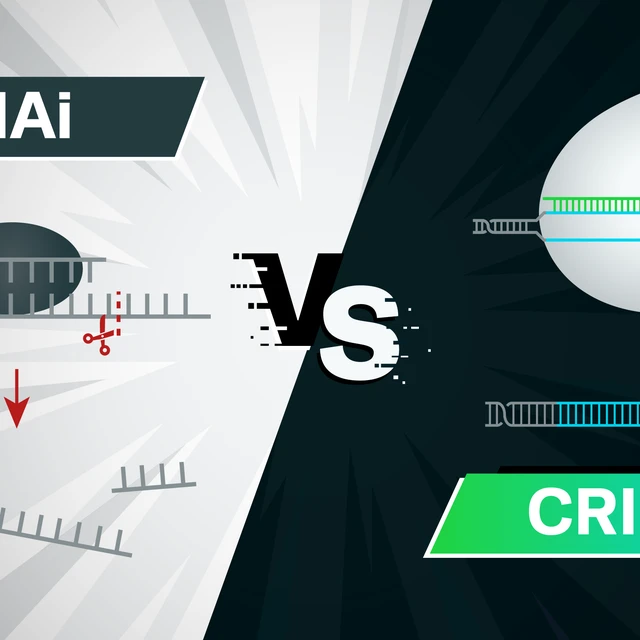
Novel Approaches for Non-Viral Delivery of CRISPR
Minu: One of the main goals of your lab is to work on delivery systems for therapeutics, right? Could you tell us more about how you guys are doing that?
Dana: In the Wilson lab, we work on the delivery problem. Cas9 is a very large enzyme, and it needs a pretty large amount of guide RNA to exert its function on the genome. Getting this large enzyme and the guide RNA into cells is actually quite a difficult feat. So, we are interested in engineering new methods to deliver that enzyme and the guide RNA into specific human cells and tissues, where we want it to perform gene editing to fix disease-causing mutations.
Most labs working on the therapeutic applications of CRISPR are using engineered viruses to get Cas9 into cells. So it's packaging the DNA instructions for Cas9, and that's what is being delivered into cells. Viruses are highly evolved and very successful at getting into cells and delivering their genomes into cells. Then, of course, it's the cellular machinery that actually makes the Cas9 and the guide RNA. So, viruses are very effective at delivering things into cells.
However, we are interested in developing non-viral methods because there will be some advantages to using a non-viral approach in some instances. What we are doing is that we are appending specific molecules to the Cas9 enzyme itself, and we are using those molecules as a key to insert into the lock of a receptor on specific cell types and using that lock and key mechanism to gain entry into specific human cell types.
Minu: Isn't that more laborious to target one cell type at a time, as every cell would have different receptors?
Dana: That's sort of the good part about it too. With gene editing, for the most part, you are not going to want to deliver Cas9 into every cell in the human body. The big challenge facing Cas9 as an in vivo therapeutic, you want to get it into the cells that you want it to go in, and not every cell in the body. Viruses have been engineered to have tropism for certain tissues, but we definitely want to see a higher level of specificity. So yes, indeed it's laborious to engineer Cas9 for each different cell type, but we think we are sort of developing a plug-and-play platform that should be—once it's up and running—pretty adaptable to different cell types.
CRISPR Cas9 Applications in Therapeutics and its Potential to Advance Disease Research
Minu: Recently, you wrote a review about clinical applications of CRISPR in therapeutics. Could you talk about how you see this field expanding and how CRISPR could change therapeutics in the future?
Dana Foss: I am really excited about CRISPR's application in the clinic. Of course, I am also excited about any version of gene therapy in the clinic. It's important to remember that the CRISPR field is building on twenty or thirty years of gene therapy research, and zinc fingers and TALENs are also exciting therapeutically with similar potential.
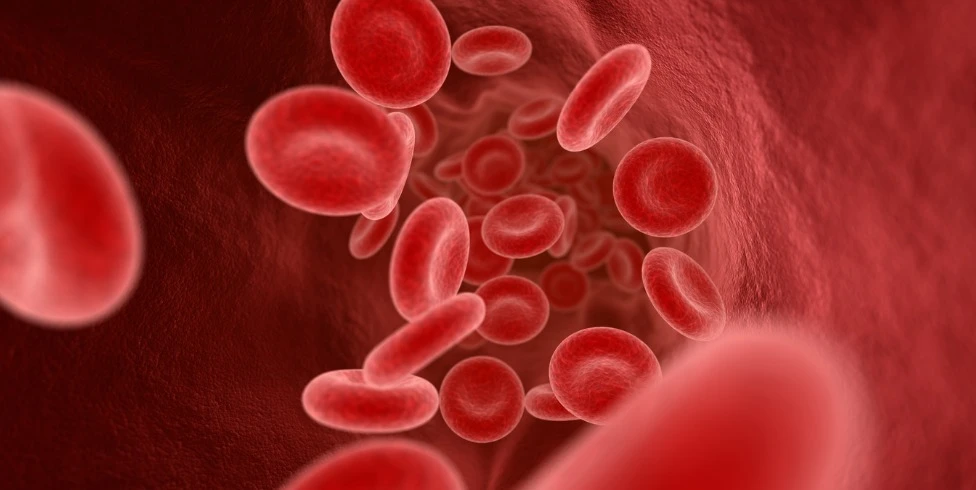
What I am most excited about in terms of the first things that CRISPR hopefully can offer in the clinic is for curing blood diseases such as sickle cell anemia and beta thalassemia. You know, these are well-studied diseases that have a rather simple genetic basis in which we can use CRISPR to make the necessary genetic edit. But most importantly, the reason that these blood diseases are being targeted first is because blood cells are very accessible. So it actually gets away from that sort of delivery issue that I was mentioning earlier.
When you are targeting blood cells, you can actually take the blood cells out of the patient and do the gene editing in a dish. And then, once the cells are corrected, and the mutation is corrected, those cells can be put back in a patient, and be curative. The ability to cure sickle cell anemia and beta thalassemia would just be such a massive impact for humankind. There's so much suffering just with those two diseases. I am super excited that I think that we have something within our lifetime, that is very likely. And this ex vivo editing, where the cells are being taken out of the patient is really going to be the first application of CRISPR in the clinic.
Minu: Are there any other big challenges in using CRISPR as a tool?
Dana Foss: I still think that the delivery issue is the main issue. One of the side issues that is related to the delivery issues is immunogenicity; it is something we are still sort of unclear about in the field. Of course, the Cas proteins are of bacterial origin, and some of them are from bacteria that humans have developed immunity to. There's sort of a lack of understanding as of now as to how big of a problem the immunogenicity is going to be.
There are two parts to that issue: whether there are too many already circulating antibodies that would neutralize Cas9 in the bloodstream, and if there are immune T-cells that might already be poised to kill cells that are expressing Cas9 because it would be a foreign protein. Immunogenicity is an issue, but what I have learned about it is that if we could control how much Cas9 actually is in the cells, and for how long, then we can minimize the immunogenicity of it. What I am trying to say is that the longer that Cas9 is expressed in a cell, as in the case of viral delivery, the more immunogenic that will be. So, those are the two issues we are trying to solve two issues at the same time, where we are trying to develop delivering the ribonucleoprotein (RNP) complex itself that is hopefully less immunogenic at the same time.
Minu: Just one more question about your projects: do you work in animal models or cells?
Dana Foss: Right now, for the most part, we are working in human cell culture and with primary human cells. But we have done some mouse work, and we are starting more of that currently.
Minu: We always end with a fun question, and I have two for you. First one: what is a quirky application of CRISPR that you may have heard of?
Dana Foss: Oh, quirky application! Maybe I have been keeping my nose to the grindstone a little too much and focusing on the serious disease applications. People using CRISPR just as an educational tool is pretty neat because then you can turn on and off genes that have a fun phenotype or fun color change. We have all seen the pictures of fluorescently green animals. I think that it's pretty quirky and pretty cute and it also gets the public's attention. As an educational tool to teach people about science, I think that's pretty fun.
Minu: Second question: if you had all the funding in the world, what is your dream project?
Dana Foss: My dream project is really to continue what I am doing now, but with unlimited resources and unlimited help. We have a small team, and I would love if we multiplied that team by a hundred with more biochemists and more resources because I think what is cool about what we are doing now is there's not a lot of people working in the same space. It’s sort of in this space where maybe it's a little too risky for industry and a little too quirky, maybe a little too applied for a lot of academia. So I am really excited, if we could really see RNP delivery of Cas9 research expand, that would be super exciting for me. Taking that all the way from all the kind of crazy experiments we are doing now all the way to try and get it in a patient and curing a disease—that's definitely my dream.
Further Reading and Learning Resources
Andre Watson, CEO of Ligandal, talks about the CRISPR delivery issue, and their approaches to solve it and make gene therapy a reality.
Megan Hochstrasser, science communications manager at the Innovative Genomics Institute, elaborates on IGI’s scicomm efforts to help people understand CRISPR in an interview.
Beeke Wienert, a researcher at IGI, recently developed DISCOVER-Seq, a new tool to detect CRISPR off-targets in vivo.
If you prefer other ways to get your CRISPR news, head over to our comprehensive list of all the best CRISPR news sources to find the best option for your favorite way to learn.
